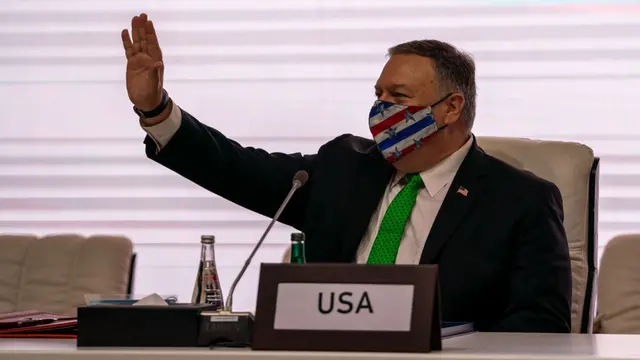Editor's note: Hannan Hussain is an assistant researcher at the Islamabad Policy Research Institute (IPRI) and an author. The article reflects the author's opinions and not necessarily the views of CGTN.
In recent weeks, Taliban insurgents and Afghan security forces have seen an uptick in violence even as negotiators from both sides attempt to break ground on intra-Afghan talks in Doha. Their most recent silver lining is an ideological compromise on the future of post-conflict governance in Afghanistan.
Abdullah Abdullah, chairman of Afghanistan's High Council for National Reconciliation, stated this week that both sides are on the verge of synthesizing their visions for Islamic rule – one that refuses discrimination against Afghanistan's disproportionately targeted minorities and sectarian groups.
Abdullah's revelation underlines the need for a broader power-sharing governance framework in Afghanistan, with concrete support from Washington. U.S. assistance to the Disarmament, Demobilization and Reintegration (DDR) of Taliban combatants can provide a critical base to incentivize the insurgents' pivot towards peace.
However, a steady decline in Washington's financial and training support has heightened the risk of losing these incentives, highlighting the need to recalibrate priorities.
The immediate costs of limiting U.S. assistance towards Afghan reintegration goals are reflected in the recent rise of transnational linkages between Taliban fighters and foreign militant groups. As early as May, the United Nations Analytical Support and Sanctions Monitoring Team identified nearly 6,500 new recruits fighting with Afghan-based terrorist groups, backed by further evidence of Al-Qaeda's support to the Taliban.
These developments run contrary to Washington's commitment in February that called for a synchronized withdrawal of U.S. troops from Afghanistan, against the Taliban's commitment to sever its ties with foreign terrorist groups. In the absence of significant U.S. financial assistance to bolster Afghanistan's post-conflict reintegration, insurgents may find little incentive in relinquishing attacks on Afghan civilians.
Early signs of the Taliban's recourse to violence are evident in its "two-track" approach to ongoing peace talks. On the one hand, the Taliban have appeared alongside government negotiators to contemplate a long-term ceasefire. On the other, Taliban insurgents have scored double-digit casualty tolls against Afghan civilians and security forces, drifting further away from any tangible U.S.-led disarmament imperative.
The United States' post-conflict involvement in Syria and Iraq offers lessons for strengthening political stability in Afghanistan. In northeast Syria, Washington has endorsed the use of transitioning militant detention centers, such as the al-Hol camp, home to thousands of suspected foreign fighters tied to the Islamic State of Iraq and the Levant (ISIL).
The scrutiny and oversight of these facilities are delegated to the Syrian Defense Forces, allowing former fighters to question the future of their involvement in violent extremism based on two rationales: new prospects for peaceful reintegration, and increased institutional capacity to monitor participant willingness.
Lessons from U.S.-led North Atlantic Treaty Organization (NATO) operations reveal similar patterns of establishing political stability in Iraq, mainly by endorsing the use of "countering violent extremism (CVE)" initiatives. The focus has been on establishing safe, accountable and effective communication lines between law enforcement entities and suspected extremist fighters.
Though limited in scale, these objectives were exercised in conjunction with the Iraqi Army and the Iraqi police between 2004 and 2011. In the presence of sufficient NATO-led peace-building assistance, Iraqi security forces withstood rapid defections among sectarian fighters and facilitated U.S. efforts to drive the ISIL out of Iraqi strongholds.
One explanation for muted U.S. support towards the DDR program in Afghanistan is its mixed result streak from previous initiatives. For 14 years, Washington supported four main Afghan reintegration programs – the Disarmament, Demobilization, and Reintegration program (DDR, 2003–2005); the Disbandment of Illegal Armed Groups program (DIAG, 2005–2011); Program Tahkim-e Sulh (PTS or Strengthening Peace Program, 2005–2011) and the Afghanistan Peace and Reintegration Program (APRP, 2010–2016).
However, government officials have often weighed the success of latter programs against the Taliban's propensity to go non-violent. This correlation has a fundamental hole.
Washington's approach to reintegration of Taliban fighters has consistently targeted factions, not localities. A 2019 survey conducted by the Asia Foundation found that a slight majority of Afghan citizens refused to identify the Afghan National Police (ANP) as their primary source of protection.
The immediate beneficiaries of this friction are the Taliban, who capitalize on the lack of U.S. reintegration initiative at the local level, easily exploiting citizen loyalties to consolidate control across countless districts.
Therefore, there is a dire need for Washington to synthesize its support for the Disarmament, Demobilization and Reintegration (DDR) program in Afghanistan with local level Taliban fighters across all factions.
Reviving DDR aid and scaling disarmament efforts nationwide is imperative, given that both the Taliban and the Afghan government demand an arrangement for post-conflict governance during ongoing talks. But they represent two contrasting visions for fulfilling that goal: a strict Islamic theocracy and a democratic republic.
(CGTN)
 简体中文
简体中文

